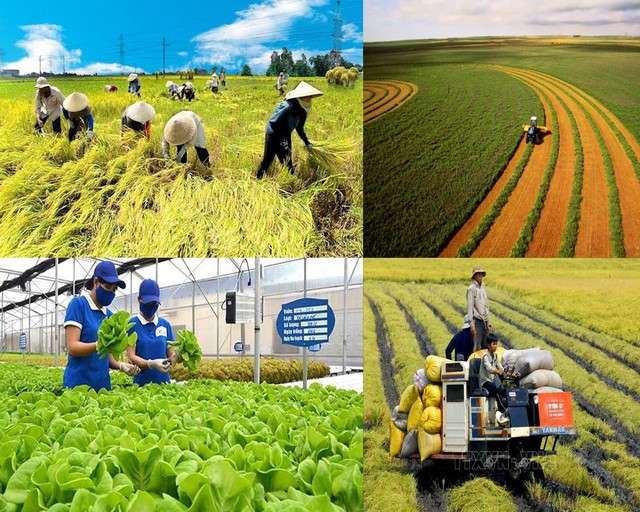Agriculture in Viet Nam: Redefining boundaries
VGP - With a strong commitment from the Vietnamese government as well as various government initiatives and the free trade agreements (FTAs), the prospects for Viet Nam’s agriculture sector are bright over the next few years.

Head of Global Trade and Receivables Finance, HSBC Viet Nam, Surajit Rakshit, made that above statement in a forum held by the European Chamber of Commerce in Viet Nam (EuroCham) and Tay Ninh Province People's Committee last week.
Surajit Rakshit noted that he has seen hundreds of breathtaking photos of Viet Nam which is well known for its picturesque landscape from North to South. Among those, the ones that capture majestic rice fields and vast green terraces are the most magnificent to him.
According to the HSBC specialist, this sparkling beauty not only underlines Viet Nam's must-see places but also tells a story of a proud nation which has transformed itself from suffering food shortage to being one of the world's leading producers and exporters of many agricultural products.
Agriculture has long been the backbone of Viet Nam's economy for a number of comparative advantages like cultivation land, forest cover, sea territories, tropical climate, available and effective labor cost.
It contributes to roughly 12.5 percent of Viet Nam's GDP. In 2022, Viet Nam's agricultural sector experienced its highest growth in recent years reaching 3.3 percent.
Breaking it down to sub sectors, farming increased by 2.8 percent, fisheries increased by 4.4 percent and forestry increased by 6.1 percent. The export turnover of the whole industry was over US$53 billion, up 9.3 percent.
Viet Nam currently exports a broad range of agricultural products all over the world. Its key exports are coffee, cashew nuts, rice and rubber, accounting for over US$10 billion worth of agricultural exports. Many of Viet Nam's agricultural products have gained access to new markets.
Viet Nam's role in global agriculture
Viet Nam's plant-based agriculture is experiencing rapid growth and Viet Nam is becoming a key player in global agriculture, stated Surajit Rakshit.
The nation was selected by the United Nations to host the 4th Global Conference of the One Planet Network's Sustainable Food Systems Program in April this year. This conference brought together experts from around the world to discuss how best to develop sustainable, resilient, healthy, and inclusive food system.
At the same time, the World Economic Forum (WEF) selected Viet Nam as one of the first three countries to pilot the Food Innovation Hub, a flagship initiative of the Food Action Alliance designed to improve sustainability in food production.
Viet Nam has also signed 15 FTAs, one more FTA negotiation recently completed in April and three others under negotiation.
Post implementing the Viet Nam-Korea Free Trade Agreement (VKFTA), Viet Nam has become the third largest mango supply market for South Korea, reaching 1,700 tons. This is equal to US$7.4 million.
On the back of the EU-Viet Nam Free Trade Agreement (EVFTA), the country has become the largest source of cashew nuts for the EU.
In the first 10 months of 2022, Viet Nam exported 98,900 tons of cashews to European markets, worth US$699 million. This represents an increase of 9.8 percent over the same period in 2021.
The EU was also the biggest importer of Vietnamese coffee and accounted for 39 percent of the exports.
Government's support
The HSBC specialist emphasized that for Viet Nam's agriculture to shine and thrive and for it to continue contributing to the country's sustainability as well as net zero goals, the Government definitely has a critical role to play.
Indeed, the country's policymakers have already been quite active in this space. To support the agricultural sector and rural development, in 2018, the Ministry of Agriculture and Rural Development (MARD) issued a list of key national products, which includes rice, coffee, rubber, cashews, pepper, tea, etc.
They are eligible for preferential support measures including exemptions from or reductions in land or water surface rents, preferential credit, human resources training, etc.
That's not all, the nation continues to implement policies to support agricultural sector and the restructuring of agricultural production to improve competitiveness, increase value-added and promote sustainable development.
In 2019, the Government introduced Resolution No. 53/NQ-CP to facilitate access to credit, the agricultural insurance program, and preferential support measures for enterprises to encourage more investment into agricultural sector and rural areas.
The Government is also focusing on tackling one of the most pressing challenges – climate change–to help agriculture sector to thrive sustainably. Due to Viet Nam's geographic exposure, it is particularly susceptible to climate change which has serious effect on agriculture.
Following Viet Nam's bold net zero commitment at COP26, the Government approved the National Green Growth Strategy 2021-2030 with vision to 2050, which is an important policy document for the country's economic growth and sustainable development, with specific goals related to greenhouse gas emission reductions.
The commitment to reduce agricultural greenhouse gases emissions has also been affirmed in MARD's Action Plan to implement the National Strategy on Green Growth for the 2021-2030 period which was approved in 2022.
Recently, the Government of Viet Nam approved the Power Development Plan 8 (PDP8), which highlights the significant investment required to develop Viet Nam's energy sector and presents potential opportunities for foreign energy firms. Once executed, this will have an impact on the agriculture sector as well.
Besides, Surajit Rakshit underlined the crucial role of financial institutions and agriculture businesses in advancing agriculture's net zero agenda by channeling green finance, educating the market and building a sustainability mindset./.

